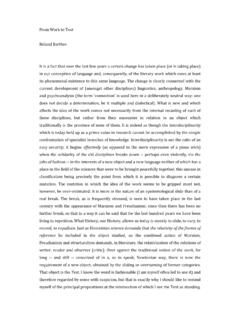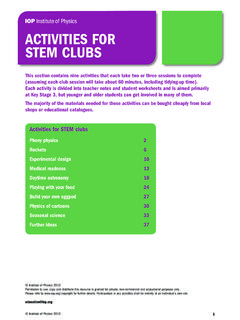Transcription of No Silver Bullet – Essence and Accident in Software ...
1 No Silver Bullet Essence and Accident in Software Engineering Frederick P. Brooks, Jr. University of North Carolina at Chapel Hill There is no single development, in either technology or management technique, which by itself promises even one order-of-magnitude improvement within a decade in productivity, in reliability, in simplicity. Abstract1. All Software construction involves essential tasks, the fashioning of the complex conceptual structures that compose the abstract Software entity, and accidental tasks, the representation of these abstract entities in programming languages and the mapping of these onto machine languages within space and speed constraints.
2 Most of the big past gains in Software productivity have come from removing artificial barriers that have made the accidental tasks inordinately hard, such as severe hardware constraints, awkward programming languages, lack of machine time. How much of what Software engineers now do is still devoted to the accidental, as opposed to the essential? Unless it is more than 9/10 of all effort, shrinking all the accidental activities to zero time will not give an order of magnitude improvement. Therefore it appears that the time has come to address the essential parts of the Software task, those concerned with fashioning abstract conceptual structures of great complexity.
3 I suggest: Exploiting the mass market to avoid constructing what can be bought. Using rapid prototyping as part of a planned iteration in establishing Software requirements. Growing Software organically, adding more and more function to systems as they are run, used, and tested. Identifying and developing the great conceptual designers of the rising generation. Introduction Of all the monsters who fill the nightmares of our folklore, none terrify more than werewolves, because they transform unexpectedly from the familiar into horrors. For these, we seek bullets of Silver than can magically lay them to rest. 1. Reproduced from: Frederick P. Brooks, The Mythical Man-Month, Anniversary edition with 4 new chapters, Addison-Wesley (1995), itself reprinted from the Proceedings of the IFIP Tenth World Computing Conference, Kugler, ed.
4 , Elsevier Science , Amsterdam, NL (1986) pp. 1069-76. F. Brooks: No Silver Bullet Essence and Accident in Software engineering (1986) 2. The familiar Software project has something of this character (at least as seen by the non-technical manager), usually innocent and straightforward, but capable of becoming a monster of missed schedules, blown budgets, and flawed products. So we hear desperate cries for a Silver Bullet , something to make Software costs drop as rapidly as computer hardware costs do. But, as we look to the horizon of a decade hence, we see no Silver Bullet . There is no single development, in either technology or management technique, which by itself promises even one order of magnitude improvement in productivity, in reliability, in simplicity.
5 In this chapter we shall try to see why, but examining both the nature of the Software problem and the properties of the bullets proposed. Skepticism is not pessimism, however. Although we see no startling breakthroughs, and indeed, believe such to be inconsistent with the nature of Software , many encouraging innovations are under way. A disciplined, consistent effort to develop, propagate, and exploit them should indeed yield an order-of-magnitude improvement. There is no royal road, but there is a road. The first step toward the management of disease was replacement of demon theories and humours theories by the germ theory. That very step, the beginning of hope, in itself dashed all hopes of magical solutions.
6 It told workers the progress would be made stepwise, at great effort, and that a persistent, unremitting care would have to be paid to a discipline of cleanliness. So it is with Software engineering today. Does It Have To Be Hard? Essential Difficulties Not only are there no Silver bullets now in view, the very nature of Software makes it unlikely that there will be any no inventions that will do for Software productivity, reliability, and simplicity what electronics, transistors, and large-scale integration did for computer hardware. We cannot expect ever to see twofold gains every two years. First, we must observe that the anomaly is not that Software progress is so slow but that computer hardware progress is so fast.
7 No other technology since civilization began has seen six orders of magnitude price-performance gain in 30 years. In no other technology can one choose to take the gain in either improved performance or in reduced costs. These gains flow from the transformation of computer manufacture from an assembly industry into a process industry. Second, to see what rate of progress we can expect in Software technology, let us examine its difficulties. Following Aristotle, I divide them into Essence the difficulties inherent in the nature of the Software and accidents those difficulties that today attend its production but that are not inherent. The accidents I discuss in the next section.
8 First let us consider the Essence . The Essence of a Software entity is a construct of interlocking concepts: data sets, relationships among data items, algorithms, and invocations of functions. This Essence is abstract, in that the conceptual construct is the same under many different representations. It is nonetheless highly precise and richly detailed. I believe the hard part of building Software to be the specification, design, and testing of this conceptual construct, not the labor of representing it and testing the fidelity of the representation. We still make syntax errors, to be sure; but they are fuzz compared to the conceptual errors in most systems. F.
9 Brooks: No Silver Bullet Essence and Accident in Software engineering (1986) 3. If this is true, building Software will always be hard. There is inherently no Silver Bullet . Let us consider the inherent properties of this irreducible Essence of modern Software systems: complexity, conformity, changeability, and invisibility. Complexity. Software entities are more complex for their size than perhaps any other human construct, because no two parts are alike (at least above the statement level). If they are, we make the two similar parts into one, a subroutine, open or closed. In this respect Software systems differ profoundly from computers, buildings, or automobiles, where repeated elements abound.
10 Digital computers are themselves more complex than most things people build; they have very large numbers of states. This makes conceiving, describing, and testing them hard. Software systems have orders of magnitude more states than computers do. Likewise, a scaling-up of a Software entity is not merely a repetition of the same elements in larger size; it is necessarily an increase in the number of different elements. In most cases, the elements interact with each other in some nonlinear fashion, and the complexity of the whole increases much more than linearly. The complexity of Software is in essential property, not an accidental one. Hence descriptions of a Software entity that abstract away its complexity often abstract away its Essence .










